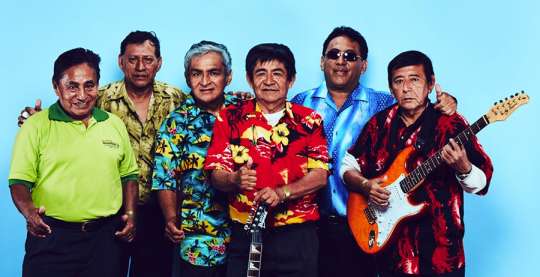|
In 2007, I made a trip to Peru in search of Afro-Peru, the music above all. My base was the tony and captivating enclave of Miraflores, in Lima, that’s set onto a promontory nearly 300 feet high. In the early morning, I’d peer down from the heights through the damp, grainy mist of winter, drawn to the wet-suited surfers riding the Pacific waves, their roar muffled by the distance between us. Not far from that vantage point I found a music shop with a trove of Afro-Peruvian goodies, but it was there that I also discovered chicha.
Chicha, or cumbia peruana, as it was called in its nascence, is uniquely Peruvian and a mainstay of the national repertoire since the late 60s, early 70s. (Chicha is named after an ancient Amerindian fermented or virgin brew made from purple corn.) It’s an idiosyncratic amalgam of musics, with jumpbacks to, of all things, the surf guitars of such as Dick Dale, e, the Ventures, Surfaris, and more; you’ll also hear strains of Peru’s romantic and old-timey criollo music, Amazonia, Afro-Latin, classic and psychedelic rock, and inevitably its backbone of cumbia from Peru, Colombia and, more recently, cumbia electronica.
Los Wembler’s de Iquitos go back to the first crop of chicha bands, led by Los Destellos, a bunch from Rimac, a working class area of Lima, that formed in 1966. In 1968, in the Amazonian port town of Iquitos, a father, Solomon Sanchez, and his five sons devised their own brand of that funky sound. La Danza Del Petrolero (Dance of the Oil Worker, of which there are many in Iquitos), their first album, was issued in 1971, as chicha boomed at home and in much of the Latin world.
After Solomon’s death a few years later, his sons lay low for some years, then began playing again, mostly local bars and parties. They stepped firmly back onto the international circuit in 2012 and are celebrating their 50th anniversary with a CD, Visión del Ayahuasca. (Ayahuasca is another ancient brew of tradition, this one hallucinogenic and used sacramentally in indigenous ceremonies, though it has penetrated mainstream Peru and far beyond.)
The CD includes a number of new songs and revisits some of the old. Production is up and all of the tunes sport vocals; even when not pitch perfect, they add to the listenability diminished by the repetitious melody of some of the older works.
The disc opens with “Lamento Selvatico,” a fine cumbia from the band’s early days since covered by many. The melody line is simple yet satisfying, and the arrangement blissfully overdosed with cumbia amazonica, whose scratchy guiro and the band’s whooping and whistling are overlaid by intriguing wahwah and other trippy guitar effects, not to discount the mark of latter-day electronica.
“Visión del Ayahuasca” is an invitation to psychedelia whose vocals sound rather like late night barroom antics; instead of delivering introspection and enlightenment, this trip is all merriment, with hard rock bass lines and guitar chords slipping over a lazy cumbia beat lighting the way for moments of surf guitar macho. "Ayahuasca" is a prime example of the more quotidian turn of the content and lyrics of the rejuvenated band. And proof positive that chicha nowadays is not out to right the wrongs of the world so much as to make it a more pleasing place in which to get through the day.

|
|
Wanna dance? “Mi Caprichito” will get even a turtle up on the dance floor with its snappy pace, super surfy guitar souped up with machine gun fast picking, and that irresistible cumbia undertow. Our undaunted hero has fallen for a sweetie, but her parents will have none of him. No worries, though, he’ll have his “party favor” just the same. (“Mi Caprichito” is one of the revisited tunes, and what were likely seen as charming lyrics in the day might seem a bit cringeworthy today.)
Other winning titles include,“Los Wembler’s Para el Mundo,” a pregón offering the combo’s Amazonian brand of “ritmo excitante” that’s energized by a driving high hat and a surf guitar riding high in the lower registers. The whooping and jungle bird and monkey caws are lots of fun, too.
"Triste Y Sola” is an easy lament to a love lost with a fetching melody and a cover of wooden percussion to dull, just enough, the pain.
Visión del Ayahuasca delivers better times, quirky licks, and the feeling that you don’t have to be high up in Miraflores to know that you’re imbibing Peru. - Carolina Amoruso
|
